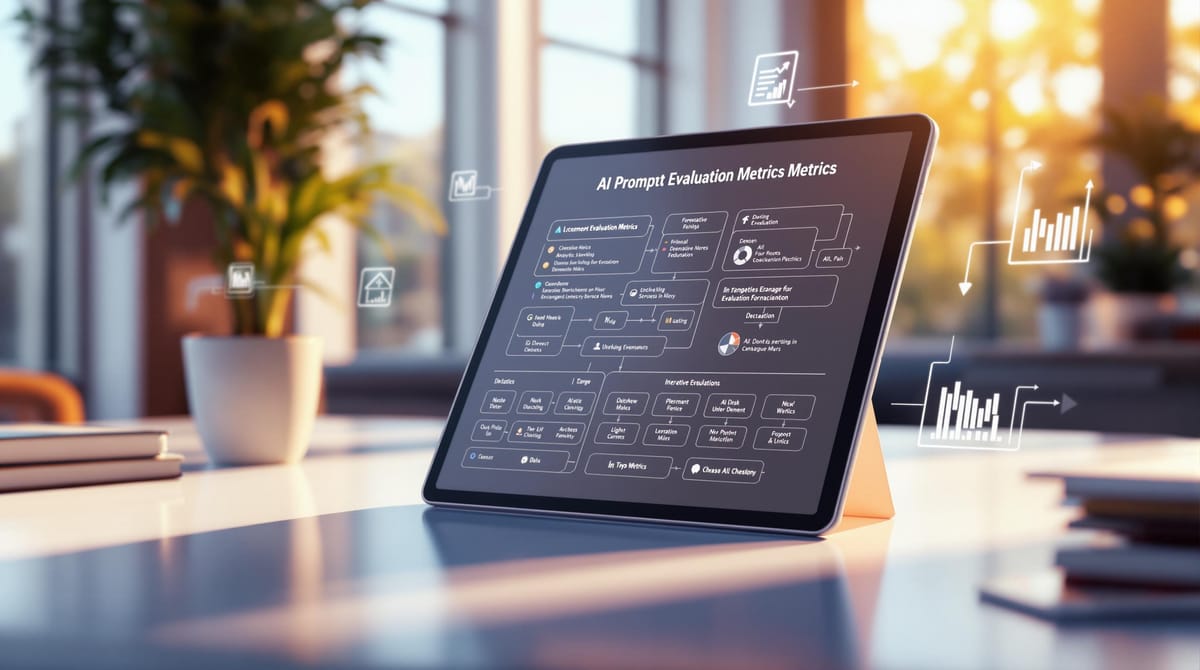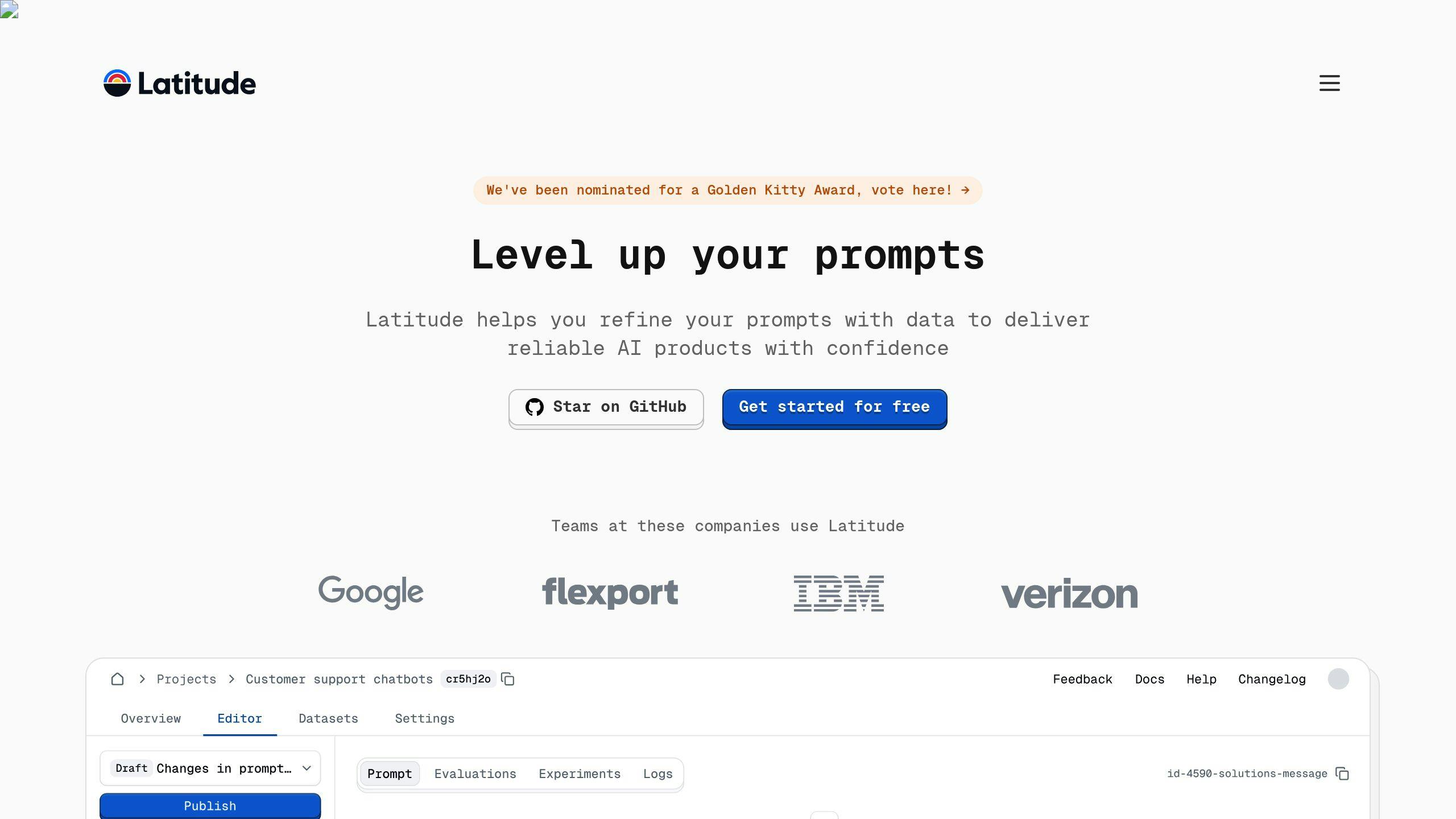Evaluating Prompts: Metrics for Iterative Refinement
Refining prompts for AI can dramatically enhance accuracy and reduce bias, using structured evaluation and diverse metrics for optimal results.

Want better results from AI models? It starts with refining your prompts. Studies show that iterative prompt refinement can boost accuracy by 30% and reduce bias by 25%. This process uses metrics like accuracy, engagement, and cost to improve outputs systematically. Platforms like Latitude and tools like DeepEval combine automated testing, human feedback, and real-time monitoring to help refine prompts effectively.
Key Takeaways:
- Why refine prompts? Better accuracy, reduced bias, and improved coherence.
- How to evaluate? Use automated tools, human feedback, and A/B testing.
- Challenges? Resource-intensive, requires constant testing and skilled oversight.
- Best practices: Set measurable goals, track performance, and balance automation with human input.
Refining prompts isn’t just about writing better instructions - it’s about ongoing evaluation to achieve consistent, high-quality results. Let’s explore the methods and tools that make it possible.
1. Latitude

Metrics Coverage
Latitude's platform focuses on tracking key performance indicators by using production logging and creating test datasets. This method allows for a structured evaluation across a variety of use cases, directly supporting the process of refining prompts over time.
Evaluation Methods
Latitude uses a mix of automated testing for measurable metrics, human feedback for qualitative insights, and production monitoring to track real-time data. This blended approach ensures a detailed evaluation of how prompts perform in different situations.
Scalability and Collaboration
Latitude stands out by combining systematic evaluation with tools designed for teamwork in prompt engineering. Its platform supports large-scale operations with features like templating and version control. Teams can work together efficiently by maintaining version histories, running production tests, and monitoring performance changes.
With integration capabilities that use real-world data, Latitude helps refine prompts systematically, ensuring high-quality and unbiased outputs from language models. These tools and methods make it easier for teams to improve prompts effectively, paving the way for further discussions on the benefits and challenges of such platforms.
Advantages and Disadvantages
When assessing iterative prompt refinement, it’s crucial to look at both its strengths and challenges. Here's a breakdown of the key aspects:
| Aspect | Advantages | Disadvantages |
|---|---|---|
| Accuracy & Performance | • 30% better accuracy [1] • 25% less bias [1] • Improved coherence |
• Requires constant testing • High resource consumption • Limited gains over time |
| Implementation | • Structured framework • Data-backed decisions • Use of measurable metrics |
• Time-consuming to set up • Complex to integrate • Demands specialized skills |
| Quality Control | • Feedback mechanisms • A/B testing • Multiple evaluation metrics |
• Risk of over-optimization • Potential evaluation bias • Maintaining consistency is tough |
| Resource Management | • Automated testing tools • Scalable workflows • Better resource allocation |
• High computational costs • Requires human oversight • Needs regular upkeep |
While iterative refinement enhances LLM accuracy and reduces bias, it also demands significant resources, careful integration, and ongoing human involvement. Striking the right balance between these factors is essential for producing high-quality results without overextending resources.
"Iterative refinement improves AI quality but needs balanced automation and oversight to avoid bias" [1].
To get the most out of this process, teams should combine various evaluation methods, set clear goals, and stick to consistent standards. This ensures that refinement efforts not only improve output quality but also manage resources wisely.
Conclusion
Refining prompts is a key step in improving the performance of language models. It leads to better accuracy, reduced bias, and more efficient use of resources. Studies show that a structured evaluation process can significantly improve the quality of outputs, making a methodical approach essential.
When refining prompts, organizations should prioritize the following areas:
| Focus Area | Key Metrics | Tools |
|---|---|---|
| Quality | Accuracy, Coherence | A/B Testing, Feedback Loops |
| Bias | Fairness, Representation | Automated Testing |
| Efficiency | Cost, Deployment Time | Logging Systems |
| Collaboration | Productivity | Prompt Management Platforms |
Platforms like Latitude offer the tools and infrastructure to execute these strategies effectively, enabling scalable and team-driven prompt engineering. By focusing on these metrics and tools, organizations can adopt practices that yield consistent and measurable improvements.
To get the best outcomes, organizations should:
- Set specific, measurable goals tied to their objectives
- Implement ongoing evaluation systems
- Follow consistent testing methods
- Combine automated tools with expert human oversight
FAQs
The following FAQs address common questions about refining and assessing prompts, building on the structured evaluation methods discussed earlier.
How can you evaluate the effectiveness of different prompts for an LLM task?
Evaluating prompts effectively involves using a mix of strategies to analyze their performance:
- Automated testing: Compare expected outputs with actual results.
- Human feedback: Gather user ratings and satisfaction scores to gauge quality.
- A/B testing: Compare prompts systematically to determine which performs better.
- Performance monitoring: Continuously track how prompts perform over time.
- Blending metrics: Combine quantitative data with qualitative insights for a well-rounded view.
"Prompt effectiveness is measured by alignment with objectives, consistency, and meeting quality standards."
How to evaluate the effectiveness of a prompt?
Evaluating prompt effectiveness involves three main approaches:
-
Quantitative Analysis
Measure metrics like accuracy, speed, and consistency. For instance, a compliance-focused implementation saw a 25% boost in accuracy and reduced manual oversight by 40% after refining prompts. -
Qualitative Assessment
Use structured feedback systems to assess clarity, specificity, and completeness of responses. -
Continuous Improvement
Tools like Latitude can help track changes and monitor refinements over time. This ensures teams can:- Systematically track improvements.
- Maintain high-quality standards.
- Adjust prompts based on performance data.
"Prompt success hinges on relevance, clarity, and alignment with objectives." - Dennis H., Author
The key is to integrate these methods while keeping clear objectives and consistent standards. Regular evaluations ensure prompts remain effective and adaptable to evolving needs.
